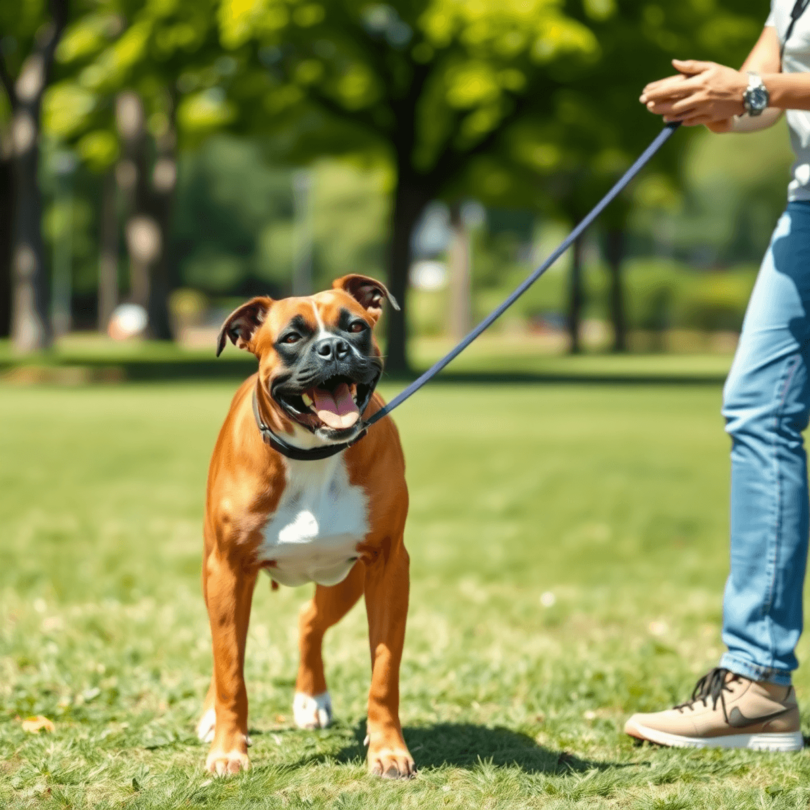Training Your Boxer: A Comprehensive Guide
Welcome to the world of Boxer dog training! This guide will take you through everything you need to know about training your beloved Boxer, ensuring a happy and well-behaved companion. Here’s what you can expect to learn:
- The unique characteristics of the Boxer breed
- The importance of training for your Boxer’s well-being and behavior
- Practical step-by-step techniques to train your Boxer effectively
Boxer Breed Overview
The Boxer is an energetic and playful breed, originally bred in Germany for bull-baiting and versatile roles as hunters and guard dogs. Known for their loyalty, Boxers exhibit a charming mix of intelligence and stubbornness. Their high energy levels require consistent mental stimulation and physical exercise.
Importance of Training
Training is crucial for Boxers because it helps them channel their energy positively. Well-trained Boxers are more adaptable to different environments, reducing anxiety and enhancing their overall behavior. Consistent training fosters a strong bond between owner and dog, making every interaction more enjoyable.
Embrace the adventure of training your Boxer—your journey together starts now!
1. Understanding Your Boxer’s Unique Traits and Learning Style
Training a Boxer begins with understanding their unique personality traits. These lovable goofballs are characterized by:
- Playfulness: Boxers are high-energy dogs that thrive on playtime. Their exuberance can make training sessions feel like a game, but it can also lead to distractions if not managed properly.
- Stubbornness: This breed has a mind of its own. Boxers may resist commands at times, testing your patience. Recognizing this trait helps in adapting training techniques to keep them engaged.
High-energy dogs like Boxers require not just physical exercise but also mental challenges. Without sufficient stimulation, they may become bored and resort to undesirable behaviors. Keeping their minds active is essential for a happy and well-behaved dog.
Consider incorporating the following into your training routine:
- Interactive toys that challenge their problem-solving skills.
- Agility exercises to combine physical activity with mental tasks.
- Short, engaging training sessions that cater to their playful nature, ensuring they stay focused.
Understanding these Boxer-specific behavior traits provides a solid foundation for effective training strategies tailored to your furry companion’s learning style. Embrace their quirks while fostering a strong bond through consistent and enjoyable training experiences.
2. Getting Started with Training Your Boxer Puppy
Starting training early with your Boxer puppy is essential. These energetic bundles of joy are eager to learn and grow. Here’s why you should kick off the training process right away:
1. Foundation Building
Early training lays the groundwork for good behavior and strong obedience. Puppies are more receptive to learning during their formative months.
2. Consistency is Key
Establishing a consistent training schedule helps your Boxer understand what to expect. Regular sessions create a routine, making it easier for them to grasp commands and behaviors.
3. Set Realistic Goals
Keep your training objectives achievable. Short, focused training sessions (around 5-10 minutes) work wonders for maintaining your puppy’s interest. Aim for specific commands or tricks each time, celebrating small victories along the way.
Tip: Use positive reinforcement techniques throughout your Boxer puppy training. Treats, praise, and playtime can significantly boost motivation.
Integrating these elements into your Boxer obedience training will set both of you up for a rewarding experience. With patience and dedication, you’ll cultivate a well-behaved companion that thrives on learning!
3. Teaching Basic Commands Using Positive Reinforcement Techniques
Teaching your Boxer basic commands is a delightful journey that strengthens your bond while ensuring their safety. Here’s a step-by-step guide to mastering fundamental commands using positive reinforcement:
Key Commands to Teach:
- Sit:
- Hold a treat close to your Boxer’s nose.
- Move your hand upward, allowing their head to follow the treat, which causes their bottom to lower.
- Once in position, say “sit” and reward them with the treat and praise.
- Stay:
- With your Boxer in a sitting position, open your palm and say “stay.”
- Take a few steps back while maintaining eye contact.
- If they stay put, return and reward them. Gradually increase distance over time.
- Come:
- Use a leash in a safe space. Say “come” enthusiastically while gently pulling on the leash.
- When they reach you, offer a treat and lots of praise.
Training Tips:
- Keep sessions short (5-10 minutes) to maintain their attention.
- Use treats or toys as rewards during training sessions for added motivation.
- Incorporate playtime between commands to enhance engagement.
Embrace the joy of teaching these essential Boxer training commands!
4. Socializing Your Boxer for a Well-Rounded Dog
Socialization is key to fostering a confident and well-adjusted Boxer. Engaging in Boxer socialization training early on lays the groundwork for a happy, adaptable dog. Here’s how to make it happen:
1. Start Early
Begin introducing your Boxer puppy to a variety of people, pets, and environments as soon as you bring them home. This helps them develop positive associations with new experiences.
2. Gradual Exposure
Slowly expose your Boxer to different situations. Take them on walks in busy areas where they can encounter various sights, sounds, and smells.
3. Sound Sensitivity
Introduce your pup to common sounds that might be startling, like fireworks or thunder. Start at a low volume and gradually increase it while providing treats and praise, helping them associate these noises with positive experiences.
4. Playdates
Arrange playdates with other friendly dogs. Supervised interactions will help your Boxer learn appropriate social behaviors while having fun.
5. Group Classes
Consider enrolling in puppy socialization classes. These structured environments provide opportunities for your Boxer to meet other dogs and people under controlled conditions.
Investing time in dog socialization techniques not only enhances your Boxer’s confidence but also nurtures their friendly disposition, paving the way for enjoyable outings together!
5. Leash Training Your Boxer: Tips for Successful Walks Together
Leash training a Boxer can be an adventurous journey. Their energy combined with enthusiasm makes walks both exciting and challenging. Here are some effective techniques to ensure your Boxer walks nicely on a leash without pulling or lunging:
Techniques for Leash Training Boxers
- Start with Short Sessions: Begin with brief walks to keep your Boxer focused and prevent overstimulation.
- Use the Right Equipment: Consider a harness designed for Boxers, which offers better control and comfort.
- Teach Loose Leash Walking: Reward your Boxer when they walk beside you without pulling. Use treats or praises to reinforce this behavior.
Managing Distractions
Walks can be full of distractions. Implement these tips to help your Boxer stay focused:
- Practice Focus Commands: Teach commands like “watch me” or “leave it” to redirect their attention when encountering distractions.
- Create Distance: If another dog or person approaches, increase the distance between them and your Boxer until they regain calmness.
- Use Treats Strategically: Carry high-value treats to reward good behavior when distractions arise.
Training your Boxer to walk on a leash is essential for enjoyable outings. A well-trained Boxer not only has fun but also ensures safe adventures together.
6. Teaching Reliable Recall: Ensuring Your Boxer’s Safety Off-Leash
Teaching Boxer recall training is essential for ensuring your furry friend’s safety during off-leash adventures. A reliable recall means you can confidently allow your Boxer to explore while knowing they will return when called.
Steps to Train Your Boxer Recall:
- Start in a Controlled Environment:
- Begin training indoors or in a fenced area with minimal distractions, which could help prevent your dog from wandering off, similar to what some owners experience as mentioned in this Quora discussion.
- Use a long leash to give them space while maintaining control.
- Use High-Value Rewards:
- Choose treats or toys that your Boxer absolutely loves.
- Show the reward and get them excited before calling them.
- Remember, using the right rewards can significantly enhance the training process, as discussed in this Whole Dog Journal blog post.
- Call Them with Enthusiasm:
- Use a cheerful tone to call your Boxer by name followed by “come.”
- Encouragement and positivity are key to grabbing their attention.
- Practice Regularly:
- Repeat the recall command several times during each session.
- Gradually increase distractions as they improve, such as other pets or noises.
- Reinforce Successes:
- When your Boxer comes, shower them with praise and rewards.
- Celebrate every successful recall, reinforcing the behavior.
- This step is crucial as it helps instill a sense of authority and respect in your dog, similar to the principles outlined in Dominance Theory.
By consistently practicing these steps, you’ll develop a strong bond through this advanced command, transforming your Boxer into a reliable companion on all their outdoor escapades.
7. Crate Training: A Useful Tool for Housebreaking and Creating a Safe Space for Your Boxer
Crate training is not only a fantastic tool for housebreaking but also provides a cozy haven for your Boxer. Imagine a snug little den where your furry friend can relax, away from the hustle and bustle of everyday life. Here are some crate training benefits:
- Cleanliness: Boxers naturally avoid soiling their sleeping areas. A crate helps them learn bladder control and establishes good potty habits.
- Safety: When you’re busy or out of the house, a crate keeps your Boxer safe from potential hazards, ensuring they don’t chew on things they shouldn’t or get into mischief.
- Comfort: Dogs are den animals by nature, and a crate creates a secure environment that can reduce anxiety.
Establishing a potty training routine using the crate is simple:
- Set a Schedule: Take your Boxer outside regularly—first thing in the morning, after meals, and before bedtime.
- Praise and Reward: As soon as they do their business outside, shower them with praise and treats to reinforce the behavior.
- Limit Crate Time: Puppies can only hold their bladder for short periods (usually one hour per month of age). Adjust crate time accordingly.
With dedication and patience, crate training transforms into an efficient method to ensure your Boxer feels safe while mastering potty training!
8. Meeting Your Boxer’s Exercise Needs Through Structured Playtime and Mental Challenges
Boxers are full of energy, and it’s important to meet their exercise needs for their overall well-being. A combination of physical activities and mental stimulation keeps them happy and healthy. Here’s what you need to know:
Exercise Requirements for Boxers
- Daily Activity: Boxers need at least 1-2 hours of exercise every day. This can include brisk walks, runs, or play sessions.
- Variety is Key: Mixing up types of activities helps prevent boredom. Include activities like fetch, tug-of-war, and agility games.
Ideas for Structured Playtime
- Interactive Toys: Use puzzle toys that challenge your Boxer to think while they play. Treat-dispensing toys are great for keeping them engaged.
- Obedience Games: Turn training sessions into a game with commands like “sit” or “stay” followed by a fun activity, rewarding them with treats or praise.
- Playdates: Socialize your Boxer with other dogs to encourage physical play and improve their social skills.
Importance of Mental Stimulation
Boxers thrive on challenges. Incorporating mental exercises alongside physical activities enhances their learning experience and prevents destructive behaviors. Activities like scent work or hide-and-seek can be incredibly engaging.
By balancing physical exercise with mental challenges, you’ll help your Boxer release energy while cultivating a joyful and obedient companion.
9. Exploring Advanced Training Techniques With Your Highly Trainable Companion (Limitations on Intense Exercise Until Full Growth is Achieved)
Boxers are not just playful pups; they are intelligent and eager learners. Transitioning from basic commands to advanced skills for Boxers opens a world of fun and engagement.
1. Teaching Tricks
Start with simple tricks like “roll over” or “play dead.” Use clear cues and positive reinforcement to encourage your Boxer. Break down each trick into manageable steps, rewarding them generously for each small success. This keeps their motivation high!
2. Consistency is Key
As training advances, maintaining consistency in your methods becomes crucial. Repetition helps solidify learning. Stick to the same commands and hand signals to avoid confusion.
3. Mind Their Limits
While Boxers thrive on mental challenges, it’s essential to respect their physical limitations until they reach maturity (around 18 months). Avoid intense exercises that may lead to injury. Focus on low-impact activities while gradually introducing more complex tricks as they grow stronger.
Advanced training isn’t just about impressing friends with cool tricks; it strengthens the bond between you and your furry friend, ensuring a well-rounded, happy Boxer ready to tackle any adventure!
10. Troubleshooting Common Issues During the Training Journey With Your Stubborn Yet Lovable Boxer Dog
Training a stubborn dog like a Boxer can come with its unique hurdles. Understanding these common behavior problems can make your journey smoother:
- Stubbornness: Boxers may resist commands if they find them uninteresting. Engage their playful nature with fun training games to maintain interest.
- Distractions: A Boxer’s curious and energetic personality means they’re easily sidetracked by sounds or sights. Use high-value treats to regain their focus when distractions arise.
- Inconsistent Commands: Stick to clear, consistent commands. Mixed signals can confuse your Boxer, leading to more stubborn behavior.
- Short Attention Span: Keep training sessions brief and engaging. Aim for 5-10 minutes, focusing on one command at a time.
With patience and understanding, you’ll navigate these challenges, turning your lovable Boxer into a well-trained companion. Enjoy the journey!
FAQs (Frequently Asked Questions)
What are the unique traits of the Boxer breed that affect training?
Boxers are known for their playful nature and high energy levels, which can make training both fun and challenging. They may exhibit stubbornness, so understanding these traits is crucial for effective training.
Why is early training important for Boxer puppies?
Starting training early with your Boxer puppy helps establish good behavior habits and socialization skills. A consistent training schedule sets the foundation for success and allows you to set realistic goals for each session.
What are some effective techniques for teaching basic commands to a Boxer?
Using positive reinforcement techniques, such as treats and praise, is highly effective in teaching fundamental commands like sit, stay, and come. Keeping training sessions short and engaging helps maintain your Boxer’s attention.
How can I socialize my Boxer effectively?
Socializing your Boxer involves gradually introducing them to various people, pets, and new experiences from an early age. This helps build their confidence and ensures they become well-rounded dogs.
What tips can help with leash training my Boxer?
To leash train your Boxer effectively, use techniques that encourage walking nicely without pulling or lunging. Managing distractions during walks, such as other dogs or people passing by, is also essential for successful leash training.
Why is reliable recall important for Boxers?
Teaching reliable recall is vital for your Boxer’s safety when they are allowed off-leash. It ensures they come back to you consistently, even in distracting environments, reducing the risk of accidents or getting lost.



